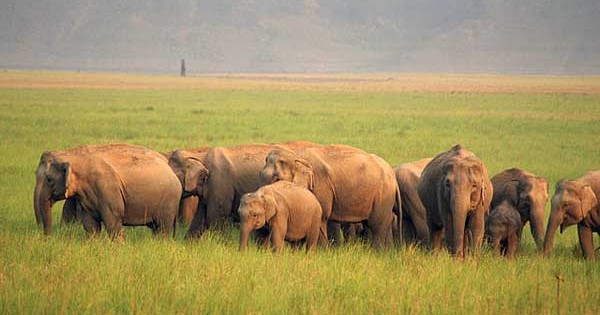Elephant: Not an Elegy
Big and bright, long-lived and loyal, they engage our imagination

Elephants are intelligent beings. They have big brains (relative to body size). They don’t forget: they have decades-long memories for watering holes, for humans of their acquaintance, and for their fellow elephant. They have many sounds, including trumpets, rumbles, gurgles, and infrasonic (low-frequency) sounds that travel for miles, soundless to us.
There are three extant species, the African elephant, Loxodonta africana, a smaller African forest elephant, Loxodonta cyclotis, and the Asian elephant, Elephas maximus. African elephants are larger and have a big dip in their back. Asian elephants have rounded or flat backs. African elephants have opposable “fingers” at the end of their trunk. With their fingered trunk they can pick up the tiniest seed. Asian elephants have just one “finger” and employ more of a scoop technique with this combination arm, hand, and nose.
Elephants are the largest of land mammals, strict herbivores that live in matriarchal herds of six to 12 or more related cows. The oldest matriarch—the natural lifespan of an elephant is 60 to 70 years—leads the group. Bulls drift off at about age 14, either to join a bachelor group or to live on their own. Bulls practice fighting other bulls, and usually get their first opportunity to mate at around age 35. It’s the largest and strongest bull that the cow accepts when she is in estrus and he in musth. (Elephants never stop growing; in the elephant lexicon, bigger means older.) After mating, bull and cow go separate ways. Bulls do little bonding; it’s the cows that bond to each other for life.
Gestation lasts for 22 months. When a calf is soon to be born, the mother moves off from the group and a mature female accompanies her for the birth. Later, the herd surrounds the calf. In their excitement the elephants trunk-touch it, rumble and trumpet, flap their ears, and urinate and defecate. Baby elephants nurse for six years. Elephant breasts are located between the mother’s front legs, allowing for much trunk caressing. Gradually the baby grows its teeth, including tusks (which are incisors, like our two front teeth), and learns to eat grass. Juveniles spend long hours playing, chasing birds and each other, twirling sticks, flapping their ears, and generally running around. Baby elephants suck their trunks.
Elephants have no predators (except us). Occasionally, though, a lion will kill a baby. When the herd perceives a pride, the adults make a wall of themselves around the juveniles.
African elephants are a keystone species in relation to the African savannah. They travel for miles feeding, breaking up trees, and eating bark and leaves as well as grass. They keep grasslands open for themselves and for animals such as zebras, antelopes, and baboons. In turn these animals provide dinner for hyenas, cheetahs, vultures, and crocodiles. Elephants spread seeds in their dung, and elephant dung provides habitat for dung beetles and other beings. Elephants can smell water from miles away. During droughts they kneel and dig with their tusks down to water. Elephant-excavated waterholes slake the thirst of all.
Elephants have molars, back teeth big as bricks and great for grinding grass. They have six pairs, and when one pair wears down another moves forward. When old elephants have worn out their last set of molars and can no longer chew, they die of starvation. As an ancient elephant grows weaker, others come to her aid, one on either side to hold her up and help her walk. When she can’t go on, they stand beside her, keeping watch while she dies. Later they remember her bones and return to them, caressing them, picking them up, carrying them around, and sometimes breaking them.
There are many painful stories about elephants. The October 2012 issue of National Geographic details the booming trade in ivory—elephant tusks. The cover trumpets the number of elephants—25,000—likely slaughtered in 2011, but the true figure, writes author Bryan Christy, “may even be double that.” You can see the killing fields from the air; “you can see which animals fled, which mothers tried to protect their young, how one terrified herd of 50 went down together.” There’s a thriving illegal trade, and “thriving” is an understatement. Ivory is alleged in some parts of the world to supply spiritual protection, and there are loopholes in the law and bribes and many tricks and much smuggling. The biggest loophole of all: “old ivory”—ivory hacked off an elephant’s face before the ban—is legal. Suddenly all kinds of ivory has become “pre-ban ivory.”
Never buy ivory of any kind.
Elephants have entered our human minds and dreams. We have Disney’s Dumbo and Barnum & Bailey’s Jumbo. We have Babar of the children’s books. We have stuffed toy elephants and a plethora of plastic pachyderms. We have our baby elephant fetishes. In Seattle it was Hansa, born at Woodland Park Zoo in 2000, to our joy, found dead in her stall in 2007, to our grief.
Still, the huge sums spent on breeding programs in zoos might be better spent preserving natural elephant habitats and aiding community-based conservation—including law enforcement against poachers. As Caroline Fraser details in Rewilding the World, any number of case studies illustrate how not to proceed. Expelling traditional agricultural communities from a park to protect its wildlife—conservation as colonialism—is problematic for elephants as well as humans. But Fraser also provides examples (particularly in Namibia) of how democratic community-based conservation combined with ecotourism can serve both wildlife and the people who live with the largest land mammal on earth. There is hope.

